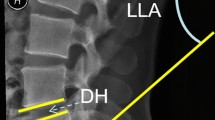Abstract
Purpose of the study
The aim of this study is to describe clinical and radiological outcomes as well as accompanying complications in a series of consecutive lateral transpsoas approaches (XLIF).
Materials and methods
A retrospective study of 39 patients treated for degenerative and post-traumatic lumbar diseases was carried out. Functional status, leg and back pain and radiological outcomes were evaluated pre and post-operatively using the Oswestry disability index score (ODI) visual analog scales (VAS) and X-ray studies.
Results
Mean follow-up was 16 months (range 12–24 months). Mean improvement in back and leg pain on VAS was 6.08 (p < 0.01) and 2.77 (p < 0.01), respectively. Mean improvement in the ODI score was 38 (p < 0.01). Increases in lumbar lordosis (32.8°–39.2°, p < 0.05) and disc height (3.6–4.8 mm, p < 0.05) were noted in the post-operative. Mild, transient strength deficit of the quadriceps muscle was also noted in ten cases with complete regression.
Conclusions
XLIF proved to be a safe, effective, minimally invasive technique that allows valid arthrodesis to be carried out. Patients achieved positive clinical outcomes and satisfactory fusion rates, with sustained restoration of lordosis, spinal alignment and disc height.








Similar content being viewed by others
References
Pimenta L (2001) Lateral endoscopic transpsoas retroperitoneal approach for lumbar spine surgery. Paper presented at the VIII Brazilian Pine Society Meeting, Belo Horizonte, Minas Gerais, Brazil, May 2001
Ozgur BM, Aryan HE, Pimenta L, Taylor WR (2006) Extreme lateral interbody fusion (XLIF): a novel surgical technique for anterior lumbar interbody fusion. Spine 6:435–443
Billinghurst J, Akbarnia BA (2009) Extreme lateral interbody fusion–XLIF. Curr Orthop Pract 20(3):238–251
Sasso RC, Best NM, Mummaneni PV et al (2005) Analysis of operative complications in a series of 471 anterior lumbar interbody fusion procedures. Spine 30:670–674
Brau SA, Delamarter RB, Schiffman ML, Williams LA, Watkins RG (2004) Vascular injury during anterior lumbar surgery. Spine J 4:409–412
Tiusanen H, Seitsalo S, Osterman K et al (1995) Retrograde ejaculation after anterior interbody lumbar fusion. Euro Spine J 4:339–342
Isiklar ZU, Lindsey RW, Coburn M (1996) Ureteral injury after anterior lumbar interbody fusion. A case report. Spine 21:2379–2382
Rajaraman V, Vingan R, Roth P, Heary RF, Conklin L, Jacobs GB (1999) Visceral and vascular complications resulting from anterior lumbar interbody fusion. J Neurosurg 91(1 Suppl):60–64
Sofianos DA, Briseno MR, Abrams J, Patel AA (2012) Complications of the lateral transpsoas approach for lumbar interbody arthrodesis. Clin Orthop Relat Res 470:1621–1632
Cho KJ, Suk SI, Park SR, Kim JH, Kim SS, Choi WK, Lee KY, Lee SR (2007) Complications in posterior fusion and instrumentation for degenerative lumbar scoliosis. Spine (Phila Pa 1976) 32:2232–2237
Scaduto AA, Gamradt SC, Yu WD, Huang J, Delamarter RB, Wang JC (2003) Perioperative complications of threaded cylindrical lumbar interbody fusion devices: anterior versus posterior approach. J Spinal Disord Tech 16:502–507
DiPaola CP, Molinari RW (2008) Posterior lumbar interbody fusion. J Am Acad Orthop Surg 16:130–139
Patel VC, Park DK, Herkowitz HN (2012) Lateral transpsoas fusion: indications and outcomes. Sci World J. doi:10.1100/2012/893608
Berjano P, Lamartina C (2011) Minimally invasive lateral transpsoas approach with advanced neurophysiologic monitoring for lumbar interbody fusion. Eur Spine J 20:1584–1586
Berjano P, Lamartina C (2013) Far lateral approaches (XLIF) in adult scoliosis. Eur Spine J 22(Suppl 2):S242–S253
Tormenti MJ, Maserati MB, Bonfield CM, Okonkwo DO, Kanter AS (2010) Complications and radiographic correction in adult scoliosis following combined transpsoas extreme lateral interbody fusion and posterior pedicle screw instrumentation. Neurosurg Focus 28:E7
Pimenta L, Oliveira L, Schaffa T, Coutinho E, Marchi L (2011) Lumbar total disc replacement from an extreme lateral approach: clinical experience with a minimum of 2 years’ follow-up. J Neurosurg Spine 14:38–45
Malham GM, Ellis NJ, Parker RM, Seex KA (2012) Clinical outcome and fusion rates after the first 30 extreme lateral interbody fusions. Sci World J 2012:246989. doi:10.1100/2012/246989
Meredith DS, Kepler CK, Huamg RC, Hegde VV (2013) Extreme lateral interbody fusion (XLIF) in the thoracic and thoracolumbar spine: technical report and early outcomes. HSSJ 9:25–31
Rodgers WB, Cox CS, Gerber EJ (2007) Experience and early results with a minimally invasive technique for anterior column support through extreme lateral interbody fusion (XLIF). US Musculoskel Rev 2:28–32
Rodgers WB, Cox CS, Gerber EJ (2010) Early complications of extreme lateral interbody fusion in the obese. J Spinal Disord Tech 23:393–397
Rodgers WB, Gerber EJ, Patterson J (2011) Intraoperative and early postoperative complications in extreme lateral interbody fusion: an analysis of 600 cases. Spine (Phila Pa 1976) 36:26–32
Youssef JA, McAfee PC, Patty CA et al (2010) Minimally invasive surgery: lateral approach interbody fusion: results and review. Spine (Phila Pa 1976) 35:S302–S311
Uribe JS, Dakwar E, Le TV, Christian G, Serrano S, Smith WD (2010) Minimally invasive surgery treatment for thoracic spine tumor removal: a mini-open, lateral approach. Spine (Phila Pa1976) 35:S347–S354
Smith WD, Dakwar E, Le TV, Christian G, Serrano S, Uribe JS (2010) Minimally invasive surgery for traumatic spinal pathologies: a mini-open, lateral approach in the thoracic and lumbar spine. Spine (Phila Pa 1976) 35:S338–S346
Tohmeh AG, Rodgers WB, Peterson MD (2011) Dynamically evoked, discrete-threshold electromyography in the extreme lateral interbody fusion approach. J Neurosurg Spine 14:31–37
Uribe JS, Vale FL, Dakwar E (2010) Electromyographic monitoring and its anatomical implications in minimally invasive spine surgery. Spine (Phila Pa 1976) 35:S368–S374
Uribe JS, Arredondo N, Dakwar E, Vale FL (2010) Defining the safe working zones using the minimally invasive lateral retroperitoneal transpsoas approach: an anatomical study. J Neurosurg Spine 13:260–266
Ebraheim NA, Xu R, Huntoon M et al (1997) Location of the extraforaminal lumbar nerve roots. An anatomic study. Clin Orthop 340:230–235
Gu Y, Ebraheim NA, Xu R et al (2001) Anatomic considerations of the posterolateral lumbar disk region. Orthopedics 24:56–58
Cummock MD, Vanni S, Levi AD et al (2011) An analysis of postoperative thigh symptoms after minimally invasive transpsoas lumbar interbody fusion. J Neurosurg Spine 15:11–18
Conflict of interest
The authors have no conflicts of interest to disclose.
Author information
Authors and Affiliations
Corresponding author
Rights and permissions
About this article
Cite this article
Formica, M., Berjano, P., Cavagnaro, L. et al. Extreme lateral approach to the spine in degenerative and post traumatic lumbar diseases: selection process, results and complications. Eur Spine J 23 (Suppl 6), 684–692 (2014). https://doi.org/10.1007/s00586-014-3545-y
Received:
Revised:
Accepted:
Published:
Issue Date:
DOI: https://doi.org/10.1007/s00586-014-3545-y




